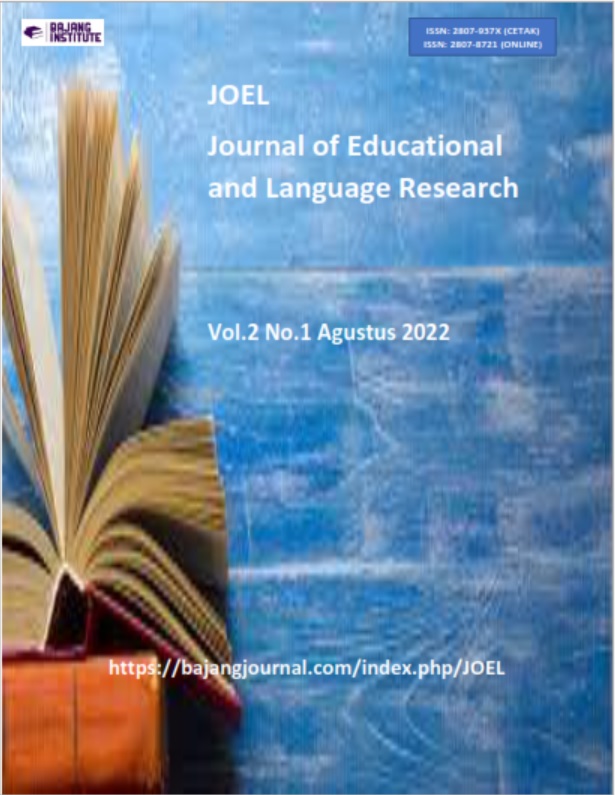PERSEPSI MAHASISWA TERHADAP PEMBELAJARAN DARING DALAM MASA PANDEMI COVID 19 DI STIKES BAITURAHIM JAMBI
DOI:
https://doi.org/10.53625/joel.v2i1.3360Keywords:
Corona Virus, Student's Perception, Online LearningAbstract
Corona Virus or known as COVID-19 has now spread to various countries in the world. COVID-19 is reported to be quite contagious with a relatively high mortality rate and is reported to continue to increase. The number of positive COVID-19 patients that continues to grow in Indonesia has forced education units to follow government regulations for the implementation of online lectures which is a national policy as a strategic step in efforts to prevent the spread of the COVID-19 virus. The purpose of the study was to determine student perceptions of online learning during the 2019 covid pandemic at Baiturahim High School of Health, Jambi. The design of this study is a quantitative research with a descriptive analytic design. The sampling technique was purposive sampling to students of the nursing undergraduate study program. The activeness and readiness of students to take online lectures 49.5% agree with online lectures, the most widely used media during online lectures is YouTube as much as 37.8%, effective learning media during online lectures using the zoom application is 37.1%, learning styles visual interest, the 2-way communication model is 54.5% such as video conferencing (zoom) and the effectiveness of online lectures is not satisfied that is 32.2% and satisfied is 31.5%. Students' perceptions of online learning during the covid pandemic are mostly good, although with various obstacles during online lectures. It takes the role of universities to provide facilities and infrastructure that support the implementation of online lectures during a pandemic.
References
Brown, Mary Daniels. 2000. Education World: Technology in the Classroom: Virtual. http://www.educationworld.com/a_tech/tech052.shtml)
Direktorat Jenderal Pencegahan Dan Pengendalian Penyakit, K. (2020). Pedoman Pencegahan Dan Pengendalian Coronavirus Disease (COVID-19). Jakarta Selatan: Direktorat Surveilans Dan Karantina Kesehatan Sub Direktorat Penyakit Infeksi Emerging.
Kemendikbud, 2020. Pusat Pendidikan dan Pelatihan Pegawai Kementrian Pendidikan dan Kebudayaan. https://pusdiklat.kemdikbud.go.id/surat edaran-mendikbud-no-4-tahun-2020-tentang-pelaksanaan-kebijakan pendidikan-dalam-masa-daruratpenyebaran-corona-virus-disease-covid-19/
Bentley, Y., Selassie, H., & Shegunshi, A. (2012). Design and Evaluation of Student-Focused eLearning. Electronic Journal of E-Learning, 10(1), 1–12.
Darmadi, H. (2017). Pengembangan model dan metode pembelajaran dalam dinamika belajar siswa. Yogyakarta: Deepublish.
Djalante, R., Lassa, J., Setiamarga, D., Sudjatma, A., Indrawan, M., Haryanto, B., Mahfud, C., Sinapoy, M. S., Djalante, S., & Rafliana, I. (2020). Review and analysis of current responses to COVID-19 in Indonesia: Period of January to March 2020. Progress in Disaster Science, 6, 100091.
Eko, K., & Rayandra, A. (2016). Pengembangan Model Pembelajaran Blended Learning Pada Aspek Learning Design Dengan Platform Media Sosial Online Sebagai Pendukung Perkuliahan Mahasiswa. Jurnal Pembelajaran Inovatif, 1–26. https://repository.unja.ac.id/626/
Eudoxie, G. D. (2011). Learning styles among students in an advanced soil management class: Impact on students’ performance. Journal of Natural Resources and Life Sciences Education, 40(1), 137–143.
Fitria. (2013). Pengaruh Persepsi E-Learning Terhadap Kepuasan Mahasiswa Kebidanan Dalam Masa Pandemik Di Stikes Muhammadiyah Gombong. Journal of Chemical Information and Modeling, 53(9), 1689–1699.
Jamaluddin, D., Ratnasih, T., Gunawan, H., & Paujiah, E. (2020). Pembelajaran daring masa pandemik Covid-19 pada calon guru: hambatan, solusi dan proyeksi. LP2M.
Kurniawati SMJ, R., Dewi, D. P., & SUDARYANTO, S. (2019). KORELASI ANTARA FAKTOR USIA, JENIS KELAMIN, DAN IPK DENGAN PERSEPSI MAHASISWA MENGENAI LINGKUNGAN BELAJAR KLINIK DI KEPANITERAAN KLINIK ILMU THT-KL FK UNDIP. Faculty of Medicine.
Maulah. (2020). Perkuliahan Daring Sebagai Sarana Pembelajaran Selama Pandemi Covid-19. Persepsi Mahasiswa Biologi Terhadap Perkuliahan Daring Sebagai Sarana Pembelajaran Selama Pandemi Covid-19 1, 1.
Mulyana, M., Rainanto, B. H., Astrini, D., & Puspitasari, R. (2020). Persepsi Mahasiswa Atas Penggunaan Aplikasi Perkuliahan Daring Saat Wabah Covid-19. JAS-PT (Jurnal Analisis Sistem Pendidikan Tinggi Indonesia), 4(1), 47. https://doi.org/10.36339/jaspt.v4i1.301
Mustofa, M. I., Chodzirin, M., Sayekti, L., & Fauzan, R. (2019). Formulasi model perkuliahan daring sebagai upaya menekan disparitas kualitas perguruan tinggi. Walisongo Journal of Information Technology, 1(2), 151–160.
Pangondian, R. A., Santosa, P. I., & Nugroho, E. (2019). Faktor-faktor yang mempengaruhi kesuksesan pembelajaran daring dalam revolusi industri 4.0. Seminar Nasional Teknologi Komputer & Sains (SAINTEKS), 1(1).
Rahmawati, R., & Putri, E. M. I. (2020). Learning From Home dalam Perspektif Persepsi Mahasiswa Era Pandemi Covid-19. Prosiding Seminar Nasional Hardiknas, 1, 17–24.
Roblyer, M. D., & Doering, A. H. (2012). Integrating educational technology into teaching.
Rusdiana, E., & Nugroho, A. (2020). Respon mahasiswa pada pembelajaran daring bagi mahasiswa mata kuliah pengantar hukum Indonesia UNESA. Integralistik, 31(1), 1–12.
Simonson, M., Zvacek, S. M., & Smaldino, S. (2019). Teaching and Learning at a Distance: Foundations of Distance Education 7th Edition.
Singh, G., O’Donoghue, J., & Worton, H. (2005). A study into the effects of elearning on higher education. Journal of University Teaching & Learning Practice, 2(1), 3.
Su, B., Bonk, C. J., Magjuka, R. J., Liu, X., & Lee, S. (2005). The importance of interaction in web-based education: A program-level case study of online MBA courses. Journal of Interactive Online Learning, 4(1), 1–19.
Suryani, Y. E. (2010). Kesulitan belajar. Magistra, 22(73), 33.











